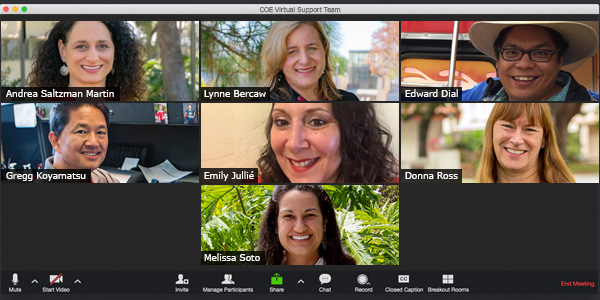
As the COVID-19 pandemic has made telework and virtual instruction the norm at San Diego State University, one household in particular has become something of a technological nerve center for the campus. In a home office, Andrea Saltzman Martin, instructional designer and lecturer in the College of Education, has worked long hours to help faculty shift their classes into the online space. In their living room, her husband Gregory Martin serves as the tech support lead for the College of Arts and Letters. And from his bedroom, their son Avi Martin works as a student assistant in the Library Hub Student Computing Center.
At the peak of the transition from in-person to virtual instruction in mid-March, the family was so busy they might as well have been in different ZIP codes.
“We sometimes pop into the same Zoom call just to say hi,” Saltzman Martin said with a laugh.
Despite the hurdles caused by the pandemic, the semester continues for students in the College of Education as everyone — students, faculty and staff — has stepped up to meet the challenges of the moment. But all of it would have been moot were it not for the extraordinary work of the COE Virtual Support Team.
I personally never have any concerns because I know Gregg and Ed are there. Frankly I feel like (COE) is in extremely good shape.The team is led by Saltzman Martin, operating systems analyst Gregg Koyamatsu and information technology consultant Edward Dial. Together with faculty fellows and student assistants, they took on the previously unimaginable task of ensuring nearly everything that happens in COE — on campus and off — could move seamlessly from classrooms, clinics and cubicles to thousands of individual homes.
—Andrea Saltzman Martin
Saltzman Martin, along with faculty members Dr. Lynne Bercaw (professor and director, School of Teacher Education), Emily Jullié (lecturer, Department of Dual Language and English Learner Education), Dr. Donna Ross (associate professor, STE) and Dr. Melissa Soto (associate professor, STE), helped faculty transition their classes through online workshops and open office hours. They provided training on Zoom and offered solutions for conducting online assessments and tests.
“They've been showing up to every session that they can,” Saltzman Martin said of the faculty fellows. “More than once they've shown up to sessions that they hadn't even signed up for just to check in and see if anyone needed help. They've been tremendous. I don't think we could manage without them, because I cannot be everywhere at once.”
With the instructional side covered, Koyamatsu and Dial worked to meet the computer hardware and software needs of faculty and staff and ensure IT systems continued to operate smoothly. At the height of the transition, between March 15 and 25, Dial said he received 175 tech support requests — roughly double their average.
“The staff all got laptops because they had used desktops before,” Koyamatsu said. “We actually put GlobalProtect (security software) on each and made sure their Zoom was ready.”
One example of the problem solving that was required: Dial worked to set up COE’s community clinics with HIPPA-compliant Zoom accounts so student clinicians could conduct confidential mental health sessions online.
“Luckily for us, they're trained therapists and they're very patient,” Dial joked. “So they were willing to work with us and they didn't get mad at us.”
Koyamatsu also mobilized his student assistants — computer engineering major Joshua Garcia, mathematics major Matthew Rodriguez Galvan, electrical engineering major Fadi Zako and electrical engineering major Agustin Cedeno — to work in shifts on a Zoom help desk to support the technological needs of COE students.
Dial credits the success of SDSU’s overall transition to chief academic technology officer James Frazee, who he says got out ahead of the crisis and created a university-wide structure to provide support efficiently where it was needed. But it’s clear the foresight and teamwork that took place within the COE Virtual Support Team was equally impressive.
“Our college is very fortunate to have our own instructional designer in Andrea,” Dial said. “Other colleges do not have a person serving in that capacity. They have to forward their instructional requests to ITS (Instructional Technology Services), where they receive excellent service, but it is not as personalized as the level of service that Andrea can provide. We are lucky to have her.”
Added Saltzman Martin: “I personally never have any concerns because I know Gregg and Ed are there. Frankly I feel like (COE) is in extremely good shape. I feel privileged to be in this college.”
